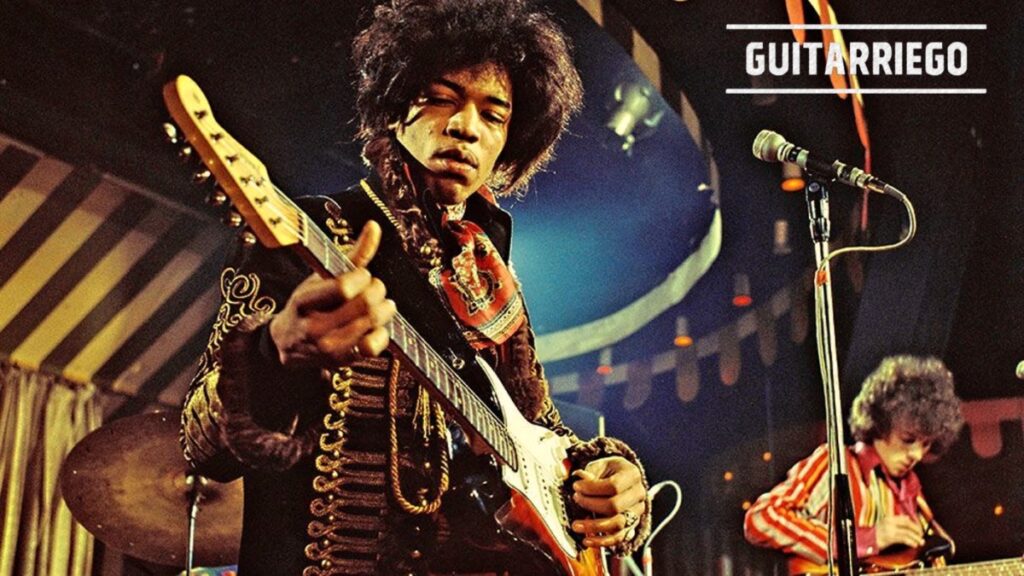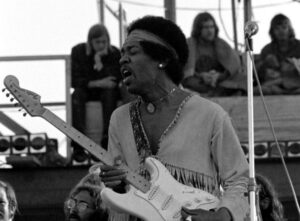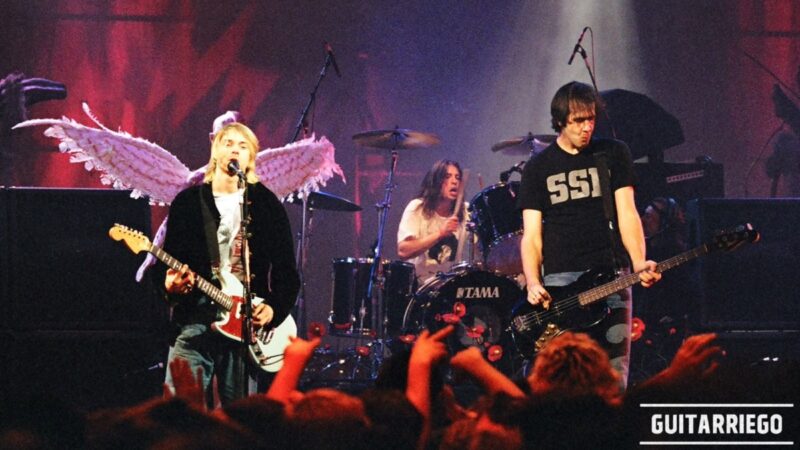Jimi Hendrix: style, tone and gear of the guitar hero

50 years ago, on September 18, 1970, the world lost Jimi Hendrix, the hero who revolutionized the world of guitar, we reviewed his style, tone, gear, technique and tricks.
Jimi Hendrix’s career and influence
Jimi Hendrix grew up listening to blues, soul and Rock and Roll guitarists. Just to name a few of his influences: BB King, Chuck Berry, Robert Johnson or Muddy Waters, marked the genius of the guitar.
The first musical groups that he formed were The Velvetones, The Rythm Kings and The King Casuals. Then he dedicated himself as a session guitarist, performing with many figures of the moment, such as Little Richard, Sam Cooke, BBKing, Tina Turner, among others.
In 1965 he ended his period as a session musician to create a new band. The name of this group was Jimi James and The Blue Flames, with which he gave small concerts in New York. From there it went directly to Great Britain where it would begin its great success, until its peak at the 1969 Woodstock festival.
Jimi Hendrix tone
The Tone of Jimi Hendrix is made up of his highly melodic style and arrangements with ligatures, vibratos, and bendings, among other techniques, along with his setup of a Fender Stratocaster plugged into a saturated Marshall Plexi.

Jimi Hendrix style, technique and tricks
Arrangements with Bonds: Hammer-on and Pull-Off
One of the main characteristics of Jimi Hendrix in his style is to embellish the chords, which give him that unique tone. The use of ascending and descending ties is probably one of its most recognized techniques. The hammer-on are very frequent and the Pull-Off- as in Little Wing. Clearly, these techniques are at the core of Jimi Hendrix’s sound, giving it that modal character with which he adorns his chords.
Chords used by Hendrix
Another of the differentiating characteristics of Jimi Hendrix and that strongly mark his style and tone, are the chords used. For starters, combine chords with and without open strings, as in Purple Haze. It also uses many major chords that do not include the third, which in turn will be accompanied by sounds taken directly from the major pentatonic scale. These major thirds are also used to leave the minor pentatonic scale, common in his compositions. The absence of the third degree of the chord is another differentiating point of its audio.
He is one of the first to use the augmented ninth in rock. Resource widely used by jazz and Rythm & Blues artists. Likewise, it also uses major novenas and sixths, which shape its characteristic harmonies. Another of its characteristics is the use of quarter intervals, which increase the tension of the musical discourse.
Scales used by Jimi
As for the scales he used, it must be said that he used almost all of them: in addition to the pentatonic already mentioned above, Jimi used any other, such as the diatonic, the chromatic, the harmonica, the blues scales (one of the favorites Jimi’s is the blues scale over E).

Jimi’s expressiveness: vibrato and bends
Two of the elements that most define the expressiveness of the Hendrix sound, and that have marked all subsequent guitarists, are vibrato and bends. These two resources are part of the development of the electric guitar, one can see the differences between the early electric guitarists and the modern ones, and that is one of the main differences. Jimi uses both resources that give his tone that expressiveness.
Vibrato with fingers and with tremolo bar
Vibrato is used by Hendrix both with his fingers and with the tremolo system on the Stratocaster’s bridge. These resources can be heard on Voodoo Chile.
Single and double bends
Jimi Hendrix uses both simple bends, that is, on a single string, or double, on two strings, as in the Fire solo. One technique he uses is bending on one note, keeping the other fixed. Thus, unison bends characterize Hendrix’s style. Later, many guitarists took this great resource from Jimi.
The unison bends consist of arriving in unison, making the bending on the lowest string, and that it reaches the same tone as the highest string. These are performed on the first and second strings, or on the second and third.
Jimi Hendrix tricks
Using the thumb
Another particular element of the genius of the guitar is the use of the thumb to close the sixth chords. By pressing the sixth string above with the thumb, when playing the chord. Thus, Jimi uses the 5 fingers of his hand to finger on the fretboard, expanding the possibilities of sounds. In Little Wing you can see this technique.

Chord slide
Another very common trick in his fluid melodic style is the use of slide to combine ninth chords. Thus, it drags the minuses between ninth chords in both directions, both up (higher) or down (lower). This is done without the need to attack or strike the strings with the pick, and take advantage of the drag force. In Castles Made of Sand and even in Little Wing this great resource is appreciated. It also does the same for the consecutive octaves so typical of the Jimi Hendrix sound.
Fold the bass
Jimi uses this resource in several songs, which is to do the same as the bass, being doubled by the bass player. Indeed, many of the recordings that Jimi played bass.
Wah-Wah
Jimi has exploited wah-wah like no one else, using this effect as another source of expressiveness and colors to his audio and songs. The best known example, and that most of us play as soon as we have a wah activated is Voodoo Chile, and its great intro riff.
Fuzz and the volume knob
Jimi when using the Fuzz played with the volume knob of his guitar to get a lead tone and also a phenomenal clean tone. Also use a very light level of fuzz to add another dimension to your clean sounds. Use the volume knob on your guitar to control it.
Hendrix gear
Hendrix Guitar
When it comes to setup, the Fender Stratocaster is the first step toward Hendrix’s tone. Jimi was left-handed, playing his Fender Strat “Izabella” backwards. Of course, the strings are reversed, reversed, which causes the bridge pickup to be reversed. That gives it a subtly different tone, which is why manufacturers like Seymour Duncan offer pickguards or pickguards with the bridge pickup set to the inverted angle.

It is worth mentioning that he also occasionally used a Gibson Flying V.
Jimi Hendrix amp
Jimi has played with Twin Reverb and 100 watt Marshall Plexi. But at big gigs where Hendrix was immortalized, like the one at Woodstock, he played a 100-watt Marshall Super Lead, 4 x 12 Marshall cabinet with Celestion Greenback G12M speakers.
Hendrix was one of the first to play with volume to achieve the harmonics of tube amps when clipping. Thus, he was a master of the use of distortion and feedback.

Marshall «Plexi» 1959SLP
Marshall ‘Plexi’ 1959SLP 100 watt saturated is the second step to achieving your audio. But it is clear that very few guitarists will actually be able to do that. Alternatively, a Marshall DSL or JCM2000 on your Classic Gain channel, or a JVM on the Clean / Crunch channel, will allow you to get that vintage overdriven audio so signature of Jimi. Finally, you have to consider the effects used by Jimi Hendrix: the wah-wah, Uni-vibe and the Fuzz Face pedal.
Effects Hendrix used
Finally, to complete Jimi Hendrix’s equipment, you have to consider the effects pedals he used. The Fuzz Face ‘Dallas Arbitrer’ distortion pedal, Cry Baby wah-wah pedal and a pedal from Univibe. Although I also sometimes used a Flanger or Phaser pedal, the fuzz, wah and Univibe are the main ones.

Jimi Hendrix signature products
There are many products, from guitars to Jimi Hendrix signature pedals. The new versions based on the original Jimi equipment. Although many have been equipped with modern specifications that include real bypass effects or amplifiers with master volume control, among others.
You can share opinions or also chat about this and more with other musicians in the comments section.
Also follow us on our Instagram @guitarriego or Facebook.






